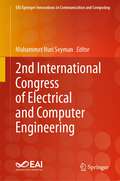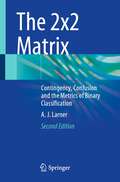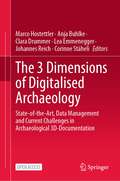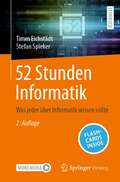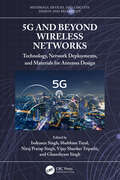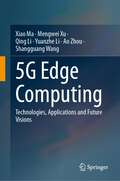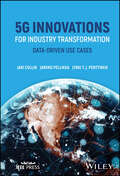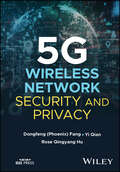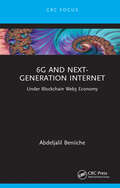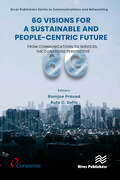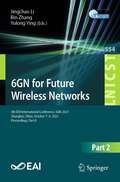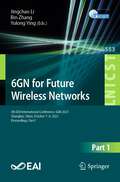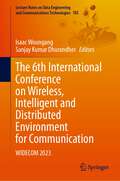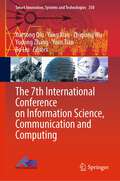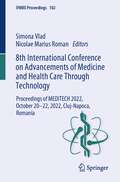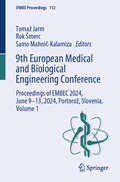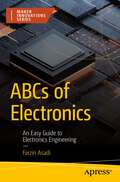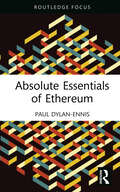- Table View
- List View
2nd International Congress of Electrical and Computer Engineering (EAI/Springer Innovations in Communication and Computing)
by Muhammet Nuri SeymanThis proceedings presents the papers included in the 2nd International Congress of Electrical and Computer Engineering (ICECENG), which took place in Bandirma, Turkey, 22-25 November 2023. The conference aims to bring together researchers, developers, and students in computing, technology trends, artificial intelligence, and security who are interested in studying the application of formal methods to the construction and analysis of models describing technological processes at both micro and macro levels. ICECENG’23 also aims to provide a platform for discussing the issues, challenges, opportunities, and findings of computer engineering research. The conference seeks to provide some answers and explore the processes, actions, challenges, and outcomes of learning and teaching.
The 2x2 Matrix: Contingency, Confusion and the Metrics of Binary Classification
by A. J. LarnerThis book describes, extends, and illustrates the metrics of binary classification through worked examples.Worked examples based on pragmatic test accuracy study data are used in chapters to illustrate relevance to day-to-day clinical practice. Readers will gain an understanding of sensitivity and specificity and predictive values along with many other parameters.The contents are highly structured, and the use of worked examples facilitates understanding and interpretation.This book is a resource for clinicians in any discipline who are involved in the performance or assessment of test accuracy studies and professionals in the disciplines of machine learning or informatics wishing to gain insight into clinical applications of 2x2 tables.
The 3 Dimensions of Digitalised Archaeology: State-of-the-Art, Data Management and Current Challenges in Archaeological 3D-Documentation
by Marco Hostettler Anja Buhlke Clara Drummer Lea Emmenegger Johannes Reich Corinne StäheliThis open access book aims to provide an overview of state-of-the-art approaches to 3D documentation from a practical perspective and formulate the most important areas for future developments. Bringing together a wide range of case studies, examples of best practice approaches, workflows, and first attempts to establish sustainable solutions to pressing problems, this book offers readers current practical advice on how to approach 3D archaeology and cultural heritage.Divided into five parts, this book begins with an overview of 3D archaeology in its present state. It goes on to give insights into the development of the technology and recent cutting-edge applications. The next section identifies current challenges in 3D archaeology and then presents approaches and solutions for data management of a large number of 3D objects and ways to ensure sustainable solutions for the archiving of the produced data. This book will be of interest to researchers working in the fields of archaeology, heritage management, and digital humanities in general.
3D Computer Vision: Foundations and Advanced Methodologies
by Yu-Jin ZhangThis book offers a comprehensive and unbiased introduction to 3D Computer Vision, ranging from its foundations and essential principles to advanced methodologies and technologies. Divided into 11 chapters, it covers the main workflow of 3D computer vision as follows: camera imaging and calibration models; various modes and means of 3D image acquisition; binocular, trinocular and multi-ocular stereo vision matching techniques; monocular single-image and multi-image scene restoration methods; point cloud data processing and modeling; simultaneous location and mapping; generalized image and scene matching; and understanding spatial-temporal behavior. Each topic is addressed in a uniform manner: the dedicated chapter first covers the essential concepts and basic principles before presenting a selection of typical, specific methods and practical techniques. In turn, it introduces readers to the most important recent developments, especially in the last three years. This approachallows them to quickly familiarize themselves with the subject, implement the techniques discussed, and design or improve their own methods for specific applications. The book can be used as a textbook for graduate courses in computer science, computer engineering, electrical engineering, data science, and related subjects. It also offers a valuable reference guide for researchers and practitioners alike.
52 Stunden Informatik: Was jeder über Informatik wissen sollte
by Timm Eichstädt Stefan SpiekerHaben Sie in Ihrer Schulzeit keinen oder nur mangelhaften Informatikunterricht erhalten? Haben Sie Kinder und würden diese gerne auf das bevorstehende Informationszeitalter vorbereiten? Nehmen Sie sich in den nächsten 52 Wochen je eine Stunde Zeit um mithilfe dieses Buches ein solides Grundwissen über Informatik zu schaffen! 52 Stunden Informatik enthält eine breit gefächerte Zusammenstellung von Lektionen, zum Lernen bzw. Lehren von Grundwissen der Informatik. Vom Nutzen des Internets bis hin zur Informationssicherheit, von deskriptiver Statistik bis hin zum neuronalen Netz sind viele wichtige Aspekte der Informatik abgedeckt. Alle Lektionen enthalten pädagogisch wertvolle Hinweise und sind mit praktischen Übungen versehen. Eine Pflichtlektüre für alle praxisorientierten Informatiklehrer*innen und Eltern, die selbst einen angemessenen Informatikunterricht verpasst haben. Die 2., aktualisierte Auflage enthält je ein neues Kapitel über ChatGPT und 3D-Druck.
5G and Beyond Wireless Networks: Technology, Network Deployments, and Materials for Antenna Design (Materials, Devices, and Circuits)
by Indrasen Singh Shubham Tayal Niraj Pratap Singh Vijay Shanker Tripathi Ghanshyam Singh5G and Beyond Wireless Networks: Technology, Network Deployments, and Materials for Antenna Design offers a comprehensive overview of 5G and beyond 5G wireless networks along with emerging technologies that support the design and development of wireless networks. It also includes discussions on various materials used for practical antenna design which are suitable for 5G, beyond 5G applications, and cell-free massive MIMO systems.The book discusses the latest techniques used in 5G and beyond 5G (B5G) communication, such as non-orthogonal multiple access (NOMA), device-to-device (D2D) communication, 6G ultra-dense O-RAN, rate-splitting multiple access (RSMA), simultaneous wireless information and power transfer (SWIPT), massive multiple input multiple output (mMIMO), and cell-free massive MIMO systems, which are explained in detail for 5G and beyond cellular networks. The description of NOMA and their benefit for 5G and beyond networks is also addressed along with D2D communication for next generation cellular networks. RSMA technique is also explained for 6G communication. Detailed descriptions for the design and development of 5G and beyond networks over various techniques are included. The materials specification to design antenna for 5G application are also given.The role of metalens in designing effective antennas and material specifications for 5G applications is explained in this book. Apart from the above emerging topics, this book also gives ideas about intelligent communication, Internet of Multimedia Things (IOMT), millimeter-wave MIMO-UFMC, and fog computing cloud networks. The last chapter gives details about the legal frameworks for 5G technology for responsible and sustainable deployment. Overall, this book may benefit network design engineers and researchers working in the area of next generation cellular networks.The contents of this book will be helpful for young researchers and master students, and network design engineers who are working in the area of next generation cellular networks.
5G and Beyond Wireless Networks: Technology, Network Deployments, and Materials for Antenna Design (Materials, Devices, and Circuits)
5G and Beyond Wireless Networks: Technology, Network Deployments, and Materials for Antenna Design offers a comprehensive overview of 5G and beyond 5G wireless networks along with emerging technologies that support the design and development of wireless networks. It also includes discussions on various materials used for practical antenna design which are suitable for 5G, beyond 5G applications, and cell-free massive MIMO systems.The book discusses the latest techniques used in 5G and beyond 5G (B5G) communication, such as non-orthogonal multiple access (NOMA), device-to-device (D2D) communication, 6G ultra-dense O-RAN, rate-splitting multiple access (RSMA), simultaneous wireless information and power transfer (SWIPT), massive multiple input multiple output (mMIMO), and cell-free massive MIMO systems, which are explained in detail for 5G and beyond cellular networks. The description of NOMA and their benefit for 5G and beyond networks is also addressed along with D2D communication for next generation cellular networks. RSMA technique is also explained for 6G communication. Detailed descriptions for the design and development of 5G and beyond networks over various techniques are included. The materials specification to design antenna for 5G application are also given.The role of metalens in designing effective antennas and material specifications for 5G applications is explained in this book. Apart from the above emerging topics, this book also gives ideas about intelligent communication, Internet of Multimedia Things (IOMT), millimeter-wave MIMO-UFMC, and fog computing cloud networks. The last chapter gives details about the legal frameworks for 5G technology for responsible and sustainable deployment. Overall, this book may benefit network design engineers and researchers working in the area of next generation cellular networks.The contents of this book will be helpful for young researchers and master students, and network design engineers who are working in the area of next generation cellular networks.
5G Edge Computing: Technologies, Applications and Future Visions
by Qing Li Shangguang Wang Ao Zhou Xiao Ma Mengwei Xu Yuanzhe LiEdge computing has been identified as one of the key technologies for 5G networks and beyond due to two prominent advantages: low network latency and reduced core network load. By empowering cloud capabilities and IT service environments at the network edge, edge computing can well support applications of 5G and beyond, such as augmented/virtual reality (AR/VR), vehicular network (ultra-reliable low-latency communication services),Internet of Things (massive machine type communication services), and mobile high-definition video (enhanced mobile broadband services). Therefore, edge computing has attracted the attention of both industry and academia since its emergence. This book highlights the progress of 5G edge computing in both industry and academia according to our long-term efforts, including the current practice of public edge providers, the research process of edge computing from academia, the integration of edge computing with 5G, and the future visions of edge computing in the 6G era. From this book, the readers can benefit from: (1) the first comprehensive measurement study on a leading public edge platform, NEP (next-generation edge platform); 2) a clear and in-depth introduction of the key technologies of 5G edge computing; (3) the latest progress of 5G-integrated edge computing; and (4) pioneering exploration of 6G edge computing based on Tiansuan constellation – an open satellite-terrestrial integrated platform. Both the researchers from academia or practitioners from industry can benefit significantly from this book.
5G Innovations for Industry Transformation: Data-driven Use Cases
by Jari Collin Jarkko Pellikka Jyrki T. Penttinen5G INNOVATIONS FOR INDUSTRY TRANSFORMATION Authoritative resource providing insight on real-life industrial 5G use cases in driving customer value, productivity, and sustainability ambitions With 5G innovations rapidly expanding to different areas within technology, 5G Innovations for Industry Transformation provides key information on how 5G technology can positively impact digital transformation in the industry sectors, discussing new data-driven business opportunities, including green digital transition, new standards for sustainability, and real-time data-driven services, introducing case studies that cover a variety of industries, from the oil & gas industry to the telecom industry, along with the lessons learned from these case studies, and providing insights into how 5G technology will transform businesses by sharing real-time customer solutions, fair data sharing principles, and ecosystem and change management. The book summarizes novelty aspects in a compact and practical way to benefit users and specialists in the field who want to understand some of the very key aspects of 5G. To aid in reader comprehension, the book contains tables, figures of technical principles and architectural block diagrams, and photographs further explaining key topics. Sample topics covered in 5G Innovations for Industry Transformation include: 5G SA technology with new capabilities, 5G private networks, and how smart, connected products are transforming competition Implications of 5G applied to your particular business and/or industry, and how to scale up and industrialize based on these implications How to lead the charge in relation to optimizing business practices based on the advent of 5G, and details on navigating the platform economy How 5G affects data privacy and security, and other integrated capabilities of 5G, such as processes, data, technology, and competencies Based on real-world experiences and high-quality research and presenting practical examples that serve as a useful guiding hand, 5G Innovations for Industry Transformation is an essential resource for change leaders, enterprise architects, and software developers of any industrial enterprise seeking to drive digitalization forward in their value chain and organization.
5G Innovations for Industry Transformation: Data-driven Use Cases
by Jari Collin Jarkko Pellikka Jyrki T. Penttinen5G INNOVATIONS FOR INDUSTRY TRANSFORMATION Authoritative resource providing insight on real-life industrial 5G use cases in driving customer value, productivity, and sustainability ambitions With 5G innovations rapidly expanding to different areas within technology, 5G Innovations for Industry Transformation provides key information on how 5G technology can positively impact digital transformation in the industry sectors, discussing new data-driven business opportunities, including green digital transition, new standards for sustainability, and real-time data-driven services, introducing case studies that cover a variety of industries, from the oil & gas industry to the telecom industry, along with the lessons learned from these case studies, and providing insights into how 5G technology will transform businesses by sharing real-time customer solutions, fair data sharing principles, and ecosystem and change management. The book summarizes novelty aspects in a compact and practical way to benefit users and specialists in the field who want to understand some of the very key aspects of 5G. To aid in reader comprehension, the book contains tables, figures of technical principles and architectural block diagrams, and photographs further explaining key topics. Sample topics covered in 5G Innovations for Industry Transformation include: 5G SA technology with new capabilities, 5G private networks, and how smart, connected products are transforming competition Implications of 5G applied to your particular business and/or industry, and how to scale up and industrialize based on these implications How to lead the charge in relation to optimizing business practices based on the advent of 5G, and details on navigating the platform economy How 5G affects data privacy and security, and other integrated capabilities of 5G, such as processes, data, technology, and competencies Based on real-world experiences and high-quality research and presenting practical examples that serve as a useful guiding hand, 5G Innovations for Industry Transformation is an essential resource for change leaders, enterprise architects, and software developers of any industrial enterprise seeking to drive digitalization forward in their value chain and organization.
5G Wireless Network Security and Privacy (IEEE Press)
by DongFeng Fang Yi Qian Rose Qingyang Hu5G WIRELESS NETWORK An expert presentation of 5G security, privacy, and network performance In 5G Wireless Network Security and Privacy, a team of veteran engineers delivers a robust and accessible discussion of 5G security solutions, including physical layer security, authentication, and mobility management. In the book, the authors expertly cover the requirements of 5G wireless network security and privacy, with explorations of existing solutions and vulnerabilities from security architecture and mechanism perspectives. Readers will learn how to enhance the security and network performance of 5G wireless networks in contexts like vehicle‐to‐vehicle and vehicle‐to‐infrastructure communications, industrial automation, health services, smart cities, and smart homes. They will develop a comprehensive understanding of 5G wireless network security as they move through the book’s 11 insightful chapters, developing in‐depth knowledge on the current state of 5G security and coming developments in the field. Readers will also find: A thorough introduction to legacy cellular network security, including network performance development from 1G to 4G In‐depth treatments of 5G network security, including the motivation and objectives of 5G wireless network security Comprehensive explorations of wireless security solutions, including cryptographic approaches and physical layer security Fulsome discussions of the security architecture of cellular networks, including 3G and 4G security Perfect for researchers and professionals working in the field of cybersecurity and 5G wireless networks, 5G Wireless Network Security and Privacy will also earn a place in the libraries of engineers, computer scientists, and graduate students studying 5G network security and privacy.
5G Wireless Network Security and Privacy (IEEE Press)
by DongFeng Fang Yi Qian Rose Qingyang Hu5G WIRELESS NETWORK An expert presentation of 5G security, privacy, and network performance In 5G Wireless Network Security and Privacy, a team of veteran engineers delivers a robust and accessible discussion of 5G security solutions, including physical layer security, authentication, and mobility management. In the book, the authors expertly cover the requirements of 5G wireless network security and privacy, with explorations of existing solutions and vulnerabilities from security architecture and mechanism perspectives. Readers will learn how to enhance the security and network performance of 5G wireless networks in contexts like vehicle‐to‐vehicle and vehicle‐to‐infrastructure communications, industrial automation, health services, smart cities, and smart homes. They will develop a comprehensive understanding of 5G wireless network security as they move through the book’s 11 insightful chapters, developing in‐depth knowledge on the current state of 5G security and coming developments in the field. Readers will also find: A thorough introduction to legacy cellular network security, including network performance development from 1G to 4G In‐depth treatments of 5G network security, including the motivation and objectives of 5G wireless network security Comprehensive explorations of wireless security solutions, including cryptographic approaches and physical layer security Fulsome discussions of the security architecture of cellular networks, including 3G and 4G security Perfect for researchers and professionals working in the field of cybersecurity and 5G wireless networks, 5G Wireless Network Security and Privacy will also earn a place in the libraries of engineers, computer scientists, and graduate students studying 5G network security and privacy.
6G and Next-Generation Internet: Under Blockchain Web3 Economy
by Abdeljalil BeniicheThe sixth generation (6G) of wireless cellular networks is expected to incorporate the latest developments in network infrastructure and emerging advances in technology. It will not only explore more spectrum at high-frequency bands but also converge driving technological trends, including connected robotics, artificial intelligence (AI), and blockchain technologies. There is also a strong notion that the nature of mobile terminals will change, whereby intelligent mobile robots are anticipated to play a more important role. Importantly, 6G will become more human-centered than 5G, which primarily focused on industry verticals. This book explores the human-centeredness of blockchain and Web3 economy for the 6G era. Aimed at graduate students, network and blockchain researchers, professionals, engineers, and practitioners, this book discusses the symbiosis of blockchain with other key technologies such as AI and robots, while putting the focus on the Tactile Internet for advanced human-to-machine interaction. By focusing on the research field of robonomics in the 6G Era, which studies the social integration of robots into the economy and human society, the book puts the various developed ideas and concepts into the perspective of the future Super Smart Society 5.0.
6G and Next-Generation Internet: Under Blockchain Web3 Economy
by Abdeljalil BeniicheThe sixth generation (6G) of wireless cellular networks is expected to incorporate the latest developments in network infrastructure and emerging advances in technology. It will not only explore more spectrum at high-frequency bands but also converge driving technological trends, including connected robotics, artificial intelligence (AI), and blockchain technologies. There is also a strong notion that the nature of mobile terminals will change, whereby intelligent mobile robots are anticipated to play a more important role. Importantly, 6G will become more human-centered than 5G, which primarily focused on industry verticals. This book explores the human-centeredness of blockchain and Web3 economy for the 6G era. Aimed at graduate students, network and blockchain researchers, professionals, engineers, and practitioners, this book discusses the symbiosis of blockchain with other key technologies such as AI and robots, while putting the focus on the Tactile Internet for advanced human-to-machine interaction. By focusing on the research field of robonomics in the 6G Era, which studies the social integration of robots into the economy and human society, the book puts the various developed ideas and concepts into the perspective of the future Super Smart Society 5.0.
6G Visions for a Sustainable and People-centric Future: From Communications to Services, the CONASENSE Perspective (River Publishers Series in Communications and Networking)
by Ramjee Prasad Rute C. Sofia6G is currently under definition, being often addressed from a plain telecommunications perspective as an evolutionary paradigm that represents an extension of 5G. Having as a horizon 2030, 6G initiatives are being deployed across the globe to further ignite the development of 6G services. At its philosophical core, 6G embodies the "human in the loop" principle. The research effort being developed towards 6G requires an interdisciplinary approach that ignites discussion across different key technological sectors, ranging from communications up to services and business cases. The contributions of this book to research in the field concern an evolutionary and interdisciplinary design of 6G as a paradigm that can be addressed by working together four different computational areas: communications; satellites and navigation; sensing; services. The book is derived from initial brainstorming that was developed during the 11th CONASENSE Symposium held in October 2021 in fortiss, Munich, Germany. Several international experts contribute to an overview of 6G key challenges, new networking trends and challenges to be overcome, and advanced 6G services. The book starts with a perspective on 6G challenges and use-cases beyond the 2030 horizon, to then continue to address the role of non-terrestrial networks and cognitive, service-centric satellite networks in future 6G services. Still with focus on 6G adaptive networking, the book continues with a debate on the need to integrate social awareness based on an interdisciplinary approach in network operations. Then, specific examples of advanced services (quantum imaging and holography; localization of the Internet of remote things) are discussed. The book is, therefore, intended to assist in developing critical thinking to back up novel networking, applications, and services towards 6G.
6G Visions for a Sustainable and People-centric Future: From Communications to Services, the CONASENSE Perspective (River Publishers Series in Communications and Networking)
by Ramjee Prasad Rute C. Sofia6G is currently under definition, being often addressed from a plain telecommunications perspective as an evolutionary paradigm that represents an extension of 5G. Having as a horizon 2030, 6G initiatives are being deployed across the globe to further ignite the development of 6G services. At its philosophical core, 6G embodies the "human in the loop" principle. The research effort being developed towards 6G requires an interdisciplinary approach that ignites discussion across different key technological sectors, ranging from communications up to services and business cases. The contributions of this book to research in the field concern an evolutionary and interdisciplinary design of 6G as a paradigm that can be addressed by working together four different computational areas: communications; satellites and navigation; sensing; services. The book is derived from initial brainstorming that was developed during the 11th CONASENSE Symposium held in October 2021 in fortiss, Munich, Germany. Several international experts contribute to an overview of 6G key challenges, new networking trends and challenges to be overcome, and advanced 6G services. The book starts with a perspective on 6G challenges and use-cases beyond the 2030 horizon, to then continue to address the role of non-terrestrial networks and cognitive, service-centric satellite networks in future 6G services. Still with focus on 6G adaptive networking, the book continues with a debate on the need to integrate social awareness based on an interdisciplinary approach in network operations. Then, specific examples of advanced services (quantum imaging and holography; localization of the Internet of remote things) are discussed. The book is, therefore, intended to assist in developing critical thinking to back up novel networking, applications, and services towards 6G.
6GN for Future Wireless Networks: 6th EAI International Conference, 6GN 2023, Shanghai, China, October 7-8, 2023, Proceedings, Part II (Lecture Notes of the Institute for Computer Sciences, Social Informatics and Telecommunications Engineering #554)
by Jingchao Li Bin Zhang Yulong YingThis 2-volume set constitutes the proceedings of the 6th EAI International Conference on 6GN for Future Wireless Networks, 6GN 2023, held in Shanghai, China, in October 7-8, 2023.The 60 full papers were selected from 151 submissions and present the state of the art and practical applications of 6G technologies. The papers are arranged thematically in tracks as follows: intelligent systems; big data mining, D2D communication, security and privacy for 6G networks; artificial intelligent techniques for 6G networks; power and energy systems I; power and energy system; power and energy systems; image, video, and signal processing; image, video, and signal processing & software engineering; communications systems and networking & control and automation systems; computer systems and applications.
6GN for Future Wireless Networks: 6th EAI International Conference, 6GN 2023, Shanghai, China, October 7-8, 2023, Proceedings, Part I (Lecture Notes of the Institute for Computer Sciences, Social Informatics and Telecommunications Engineering #553)
by Jingchao Li Bin Zhang Yulong YingThis 2-volume set constitutes the proceedings of the 6th EAI International Conference on 6GN for Future Wireless Networks, 6GN 2023, held in Shanghai, China, in October 7-8, 2023. The 60 full papers were selected from 151 submissions and present the state of the art and practical applications of 6G technologies. The papers are arranged thematically in tracks as follows: intelligent systems; big data mining, D2D communication, security and privacy for 6G networks; artificial intelligent techniques for 6G networks; power and energy systems I; power and energy system; power and energy systems; image, video, and signal processing; image, video, and signal processing & software engineering; communications systems and networking & control and automation systems; computer systems and applications.
The 6th International Conference on Wireless, Intelligent and Distributed Environment for Communication: WIDECOM 2023 (Lecture Notes on Data Engineering and Communications Technologies #185)
by Isaac Woungang Sanjay Kumar DhurandherThis book presents the proceedings of the 6th International Conference on Wireless Intelligent and Distributed Environment for Communication (WIDECOM 2023), which took place at Brock University, St. Catharines, Ontario, Canada, October 11-13, 2023. The book addresses issues related to new dependability paradigms, design, and performance of dependable network computing and mobile systems, as well as issues related to the security of these systems. The goal of the conference is to provide a forum for researchers, students, scientists and engineers working in academia and industry to share their experiences, new ideas and research results in the above-mentioned areas.
The 7th International Conference on Information Science, Communication and Computing (Smart Innovation, Systems and Technologies #350)
by Xuesong Qiu Yang Xiao Zhiqiang Wu Yudong Zhang Yuan Tian Bo LiuThis conference proceedings is a collection of the accepted papers of ISCC2023 - the 7th International Conference on Information Science, Communication and Computing held in Chongqing, China, 2-5 June 2023. The topics focus on intelligent information science and technology, artificial intelligence and intelligent systems, cloud computing and big data, smart computing and communication technology, wireless network, and cyber security. Each part can be used as an excellent reference by industry practitioners, university faculties, research fellows, and undergraduate and graduate students who need to build a knowledge base of the latest advances and state of the practice in the topics covered by this conference proceedings. This will enable them to build, maintain and manage systems of high reliability and complexity. We would like to thank the authors for their hard work and dedication, and the reviewers for ensuring that only the highest quality papers were selected.
8th International Conference on Advancements of Medicine and Health Care Through Technology: Proceedings of MEDITECH 2022, October 20–22, 2022, Cluj-Napoca, Romania (IFMBE Proceedings #102)
by Simona Vlad Nicolae Marius RomanThis book gathers the proceedings of the 8th International Conference on Advancements of Medicine and Health Care through Technology, MEDITECH 2022, held virtually on 20–22 October 2022, from Cluj-Napoca, Romania. It reports on both theoretical and practical developments in biomedical imaging and image processing, health technology, technologies for education, and biomedical signal processing and medical devices, measurements and instrumentation. Both the conference and the realization of this book were supported by the Romanian National Society for Medical Engineering and Biological Technology (SNIMTB).
9th European Medical and Biological Engineering Conference: Proceedings of EMBEC 2024, June 9-13, 2024, Portorož, Slovenia, Volume 1 (IFMBE Proceedings #112)
by Samo Mahnič-Kalamiza Tomaž Jarm Rok ŠmercThis book informs on new trends, challenges, and solutions, in the multidisciplinary field of biomedical engineering. It covers traditional topics in biomechanics and biomedical signal processing, as well as recent trends relating to the applications of artificial intelligence and machine learning methods in medicine and biology, and to bioengineering education. Gathering the second volume of the proceedings of the 9th European Medical and Biological Engineering Conference (EMBEC 2024), held on June 9-13, 2024, in Portorož, Slovenia, this book bridges fundamental and clinically-oriented research, emphasizing the role of translational research in biomedical engineering. It aims at inspiring and fostering communication and collaboration between engineers, physicists, biologists, physicians and other professionals dealing with cutting-edge themes in and advanced technologies serving the broad field of biology and healthcare.
9th European Medical and Biological Engineering Conference: Proceedings of EMBEC 2024, June 9-13, 2024, Portorož, Slovenia, Volume 2 (IFMBE Proceedings #113)
by Samo Mahnič-Kalamiza Tomaž Jarm Rok ŠmercThis book informs on new trends, challenges, and solutions, in the multidisciplinary field of biomedical engineering. It covers traditional topics in biomechanics and biomedical signal processing, as well as recent trends relating to the applications of artificial intelligence and IoT in healthcare, wearable devices for patient monitoring, monitoring of medical devices, machine learning applications in medical data, among others. Gathering the second volume of the proceedings of the 9th European Medical and Biological Engineering Conference (EMBEC 2024), held on June 9-13, 2024, in Portorož, Slovenia, this book bridges fundamental and clinically-oriented research, emphasizing the role of translational research in biomedical engineering. It aims at inspiring and fostering communication and collaboration between engineers, physicists, biologists, physicians and other professionals dealing with cutting-edge themes in and advanced technologies serving the broad field of biology and healthcare.
ABCs of Electronics: An Easy Guide to Electronics Engineering (Maker Innovations Series)
by Farzin AsadiLearn the fundamental principles of electronic components in a simple, easy-to-follow text. This book is a must-have for anyone seeking to master the basics of electronic engineering.Completely avoiding unnecessary complex technical concepts and highly mathematical terms, chapters are presented in simple language, using analogies that are familiar to everyone. From deciphering schematics to practical implementation, the knowledge imparted in these pages opens doors to exciting possibilities. You'll gain a solid understanding of crucial components like diodes, transistors, relays, ICs, DC motors, and more.Whether you're a student looking to grasp the fundamentals or a maker eager to bring your projects to life, ABCs of Electronics is your essential companion. What You'll LearnGain the skills to read and implement electronic schematicsDevelop a practical understanding of digital electronics, logic gates, and prototyping platforms.Discover how to work with DC motors and relays for various electronic applications.Acquire essential electronics knowledge Simplify the complexities of electronics and offer practical, hands-on guidance.Who This Book Is ForMakers, high school and college students pursuing electronic engineering, individuals with a general interest in electronics, and anyone seeking a practical and simplified approach to learning the fundamentals of electronics.
Absolute Essentials of Ethereum (Absolute Essentials of Business and Economics)
by Paul Dylan-EnnisAbsolute Essentials of Ethereum is a concise textbook which guides the reader through the fascinating world of the emerging Ethereum ecosystem, from the basics of how its blockchain works to cutting-edge applications.Written by an experienced educator, each chapter is designed to progress potential students from class to class. Technical concepts are clearly explained for those new to the topic and readers are supported with definitions and summaries in each chapter. Real-life case studies situate the overviews in a contemporary context. Topics covered include the Ethereum Execution and Consensus layers, Ethereum governance and community, Decentralised Autonomous Organisations (DAOs), Decentralised Finance (DeFi), Non-Fungible Tokens (NFTs) and Layer 2.This book is the ideal text to support undergraduate and postgraduate courses on blockchain technologies, cryptocurrencies, Web3 and fintech, as well as for those who want to know how Ethereum really works.
